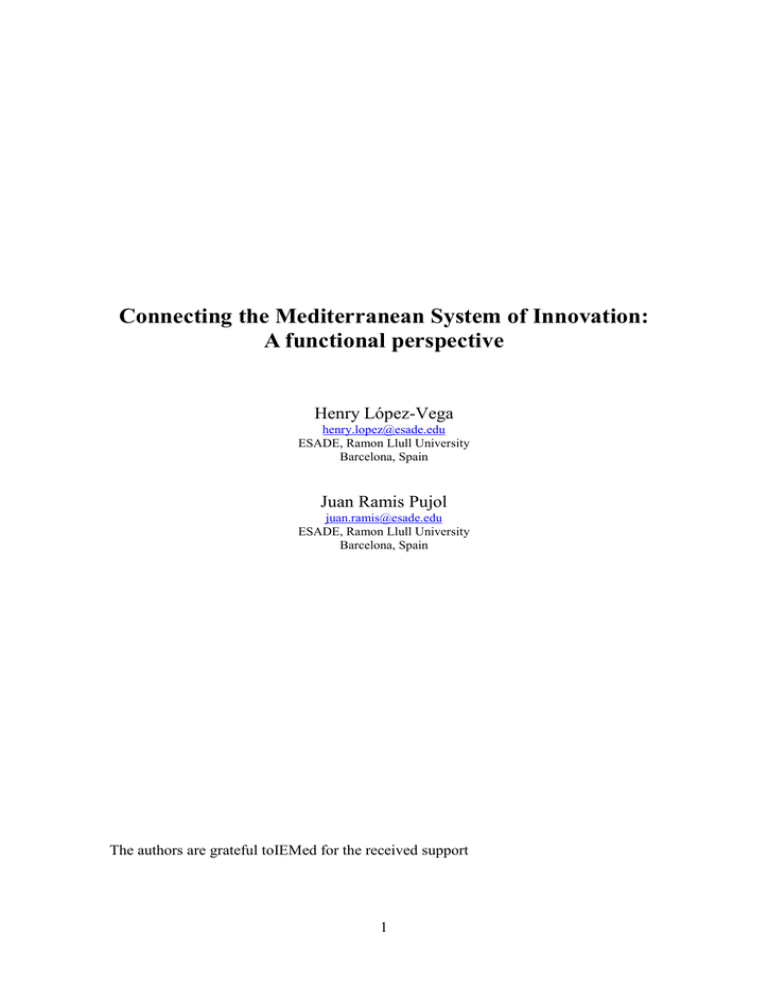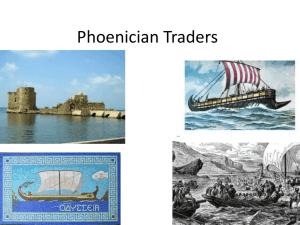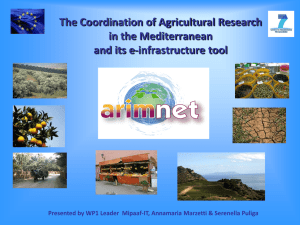Connecting the Mediterranean System of Innovation: A functional perspective Henry López-Vega
advertisement

Connecting the Mediterranean System of Innovation: A functional perspective Henry López-Vega henry.lopez@esade.edu ESADE, Ramon Llull University Barcelona, Spain Juan Ramis Pujol juan.ramis@esade.edu ESADE, Ramon Llull University Barcelona, Spain The authors are grateful toIEMed for the received support 1 Abstract Purpose - This paper provides the first qualitative exploratory overview of the Mediterranean System of Innovation (MSI) and presents the results of an interactive work with 25 different innovation delegates from northern and southern Mediterranean countries. The study comes at the turning point where the Union for the Mediterranean is designing the innovation policies and debating the mechanisms to boost the central activities. Design / Methodology / Approach - This research applies the literature of National Systems of Innovation, applying the functions perspective, to study the means Mediterranean countries use to advance its innovation capacity. In collaboration with IEMed, this research invited delegates from northern and southern Mediterranean countries, program directors and European Commission representatives to present the activities in their countries. Findings- The data shed light on the most relevant enabling and blocking mechanisms for innovation as well as showed that R&D support is slightly changing to services and business models. Finally, it highlighted the relevance of having a defined innovation strategy necessary for increasing the existing capabilities. Originality / value - The value of this research represents the use of the system of innovation functions perspective to explore the Mediterranean region. Further research could focus on exploring the differences between the northern and southern Mediterranean countries. Keywords - Mediterranean System of Innovation, Innovation, Intermediaries Paper type - Research paper Introduction The field of Systems of Innovation approach has existed for a little more than two decades, following the seminal work by Freeman (1987). Currently, it is used for the systemic study of the “elements and relationships which interact in the production, diffusion and use of new knowledge (Lundvall, 1992)”.This arrangements aim to increase market interactions, stimulating the generation and transfer of knowledge, skills and competences necessary for the formation of spillovers and economic growth. Research in systems of innovation has progressively expanded the focus of its study, traditionally at the national level (; Lundvall, 1992; Nelson, 1993), to explain innovation at the continental (Freeman, 2002), regional (Cooke, et al. 2004), sectoral (Malerba, 2004) and technological levels (Bergek et.al. 2008). Further, it contributed to other theoretical fields such as innovation, and social networks (Dodgson 2008; Assimakopoulos 2007), knowledge and learning (Lorenz and Lundvall 2006) and innovation policy (OECD 2008). Up to know empirical research has focused on specific industries or institutional factors avoiding a broader explanation of National System of Innovation (Tylecote 2007; 2 Eickelpasch and Fritsch, 2005) or offered a broad perspective which does not explain how institutions shape organization’s innovative behavior (Mowery and Rosenberg 1993, Nelson 1993). The former approach has focused on sectors such as biotechnology and E-economy (OECD 1997; Dodgson, et al. 2008; Lester 2001). The latter approach includes broader longitudinal explanations of national systems (Freeman 2001; Nelson 1993) that covered a wide range of organizations, institutions in both developed countries (Arundel, et al., 2007) and catching up ones (Hu and Mathews, 2005; Motohashi and Yun 2007). Recently, efforts have been conducted to the study of Continental systems of innovation such as Europe (Arundel et al., 2007) or Scandinavia (Lundvall, 2008). A review of the literature on the Mediterranean System of Innovation (MSI) 1, however, revealed no single contribution has made the effort to comprehend the dynamics and components of it. Accordingly, the Mediterranean area should have an initial exploratory analysis of the organizations and institutions affecting its development. This analysis is relevant on the light of the ongoing turning point to consolidate the Union for the Mediterranean that will have major implications on the future innovation policies as well as on the depollution of the Mediterranean Sea, the establishment of maritime and land highways, civil protection initiatives to combat natural and man-made disasters, a Mediterranean solar energy plan, the inauguration of the Euro-Mediterranean University in Slovenia, and the Mediterranean Business Development Initiative focusing on micro, small and medium-sized enterprises. Accordingly, this paper explores the functioning presenting some evidence on the functions of the Mediterranean System of Innovation (Edquist, 2006). The novelty of this contribution, apart of been the first one of its kind at the Mediterranean system level, it highlights the perceived relevance of intermediary organizations connecting organizations across regions. Our discussion proceeds by analysing data provided by 25 selected innovation actors such as politicians, project managers and academics from various Mediterranean countries in collaboration with the Institut Europeu de la Mediterrània IEMed (European Institute of the Mediterranean). We study the MSO through the following 1 Our analysis is based on the Social Science Citation Index (SSCI) of Thomson-ISI available on the online database and consistent with the aim of our focus of study. 3 research questions: a) how the Mediterranean System of Innovation (MSI) accomplishes the innovation system functions? Our results suggest the MSI has partially accomplished different innovation functions. However, the collected data revealed that the design of the system of innovation strategy and the role of intermediary organizations are two central activities for the development of the system. The remainder of this paper is structured as follows. Section 2 describes the literature review on systems of innovation and each of the functions mentioned in the literature. The third section describes our research design. We continue in section 4 where we integrate our empirical data in the functions perspective of the systems of innovation. The final section summarizes the research and offers suggestions for further research. Literature Review The field of Systems of Innovation (SI) approach can be interpreted as institutional arrangements to provide connectivity among economic actors (Carlsson, 2007). These attempt to increase market interactions stimulating the generation and transfer of knowledge, skills and competences necessary for the formation of spillovers and economic growth. In this respect, the system of innovation framework is based on the following core aspects: first, it places innovation and learning process at the centre of the focus, second, it employs historical and evolutionary perspectives; thirdly, it emphasizes the idea of interdependency, and non-linearity and finally emphasizes the role of institutions for promoting innovation (Edquist, 2006). These aspects offer researchers with the sufficient perspective to explain the performance and transformation of systems at different levels of analysis. Edquist (1997) suggest studies on systems of innovation include “all important economic, social, political, organizational, institutional, and other factors that influence the development, diffusion and use of innovations (Edquist 1997)”. Most of these studies emphasize the two-way relationship of mutual embeddedness between institutions and organizations that influences the performance and change of the system. Further, systems of innovation are conceptualized as the set of institutions and organizations along with the relationships among them. Institutions influence the interaction of public and private organizations. These are understood as sets of common habits, routines, established practices, rules or laws that regulate the relations and 4 interactions between individuals and groups (Edquist and Johnson, 1997) and reduce the uncertainty by providing information and incentives. On the other hand, organizations represent the main vehicles for innovation in that they create, develop and diffuse groups of technologies. These include private as well as public organizations e.g. firms, universities, industry associations, scientific and professional societies, regulatory agencies, organizations for higher education and research technology, support entities and intermediaries. Functions of Systems of Innovation An established contribution to the study of systems of innovation represents the function approach (Chaminade and Edquist, 2005; Liu and White, 2001; Gali and Teubal, 1997) that is used to explain how an innovation system works in comparison to how it is composed or structured (Markard and Truffer, 2008). According to Jacobsson and Bergek (2004) and Hekkert et al. (2007), the fundamental reasons that justify the use of the functions approach are: 1) it allows researchers to conduct comparisons between innovation systems with different institutional set-ups; 2) it enables a more systematic method for mapping the determinants of innovation cycles and feedback loops and 3) it makes it possible to deliver a clear set of policy targets as well as methods to meet these targets. Table 1 presents selected contributions to the functions perspective, the four groups of innovation activities to be considered by policy makers and the suggested indicators that describe the overall dynamics of innovation systems. Following, this paper briefly presents these four themes and sub-themes. Provision of Knowledge inputs to the innovation process This function, provision of R&D and competence building, emerged out of the perspective of interactive learning proposed by Lundvall (1992). It has evolved and focused on the how knowledge is created, transferred and exploited (David and Foray 1995; Johnson and Jacobsson 2003; Lam and Lundvall 2006) as well as the learning capability of individuals, organizations and regions related to human resource development and competence building (Lundvall et al., 2002). 5 Table 1. Overview of the Functions of Innovation Systems Grouping innovation activities and policy Provision of Knowledge inputs to the innovation process Provision of marketsdemand site factors Provision of constituencies to innovation system Edquist (2006) Bergek et al. (2008) Gali and Teubal (1997) Indicators for innovation systems Provision of R&D and competence building Knowledge Development and Diffusion R&D activities and supply of scientific and technical services to third parties R&D projects, network size and intensity; size and orientation of R&D projects; learning curves; development of a new technology Articulation of quality requirements (demand side) Influence on the direction of search Policy making by governmental entities Targets set by governments; no. press articles; incentives from taxes; regulatory pressure Formation of new product markets Market formation Diffusion of scientific culture through science centres No. of niche markets; lead users; customer groups; actor strategies, market size; purchasing processes Creating and changing organizations for the development of new fields of innovation Entrepreneurial Experimentation Networking through markets and other mechanisms Changing institutions that provide incentives or obstacles to innovation Support services for innovation firms 1) Incubating activities; 2) Financing of innovation activities, 3) Provision of consultancy services of relevance for innovation processes - No. of new entrants and diversifying established firms; no. experiments; no. of diversifying activities of incumbents; breath of technologies used Development of positive external economies Diffusion of information, knowledge and technology between suppliers and users Specialized intermediaries, information flows, political power, pooled labour markets Legitimation Professional coordination through academies, professional associations, etc. Rise and Growth of interest groups and their lobby actions; visions and expectations; alignment with current legislation Resource mobilization Implementation of institutions e.g. laws, . Functions usually performed by intermediary organizations Volume capital and VC, volume and quality of human resources, complementary assets 6 Traditionally, this activity has been carried out by public research centres and financed by public agencies. However, recent policy instruments promote a change towards more interactive involvement coming from private organizations towards either developing already basic research or co-investing in new lines research for producing basic research. Provision of markets-demand site factors These two functions involve the 1) articulation of quality requirements from the demand side and 2) the formation of new product markets. The former one refers to the activities of organizations, institutional mechanisms and demand side that can influence on the direction of search of new technologies, strategies, etc. This function involves an interactive match of, for example: visions, expectations and beliefs in growth potential, regulations and policy, articulation of demand from leading customers and crisis in current businesses. The second activity, formation of new product markets, studies the factors driving and hindering market formation such as the articulated demand, price/performance of new technologies, market demands and protected spaces for technologies. Finally, the result of this analysis should explain the mechanism and customer’s preferences that facilitated the formation of new markets and technologies, revealing the (un) efficiency of different mechanisms. Provision of constituencies to the innovation system This function explores the three inputs to the innovation system: 1) creating and changing organizations for the development of new fields of innovation, 2) networking through markets and other mechanisms and 3) legitimacy. The function, creating and changing organizations for the development of new fields of innovation, supports the deployment of new technologies through the creation of new start-ups or new entrepreneurial activities in established firms. Entrepreneurial experimentation is measured using the number of new entrants, number of different types of applications and the breath of technologies used, as well as the character of technologies employed (Bergek et al., 2008). The second function, networking through markets and other mechanisms, explores the ongoing continuous interaction among firms, universities and users where networks or clusters of firms facilitate the exchange of information (Carlsson and Stankiewicz, 1991). Further, it analyzes the mechanisms that facilitate the 7 formation of learning relations among a variety of actors in innovation processes as well as the emergence or entry of positive externalities i.e. new entrants, specialized intermediate goods and service providers. Finally, legitimacy is a matter social acceptance and compliance with relevant institutions (Bergek et al., 2007). It is considered as a conscious process, through continuous actions between public and private organizations and individuals. The process of legitimation is aligned to the institutional alignment and enactment of new institutions i.e. incentives or obstacles to innovation. Support services for innovation firms Finally, the formation and development of systems of innovation depends on the support services provided by private and public organizations that include: 1) Incubating activities, 2) financing innovation processes and 3) provision of consultancy services (Edquist, 2006). The first one involves the provision of facilities and administrative support for innovation projects. The second involves the activities necessary for commercializing and facilitating the diffusion of R&D. Finally, the last activity involves the provision of consultancy advice for the commercialization and appropriation of technologies. Research Design This research was carried in collaboration with the European Institute of the Mediterranean (IEMed) as part of the first study on innovation for the Union for the Mediterranean. This process initiated with a formal meeting in Barcelona on the 12th of February at the IEMed workshop “Innovation as a Motor of Development in the EuroMediterranean Region”. At the meeting, 25 selected innovation actors such as politicians, project managers and academics from various Mediterranean countries were invited to presented their national projects and provided comments in four different work-sessions: 1) Promotion of business innovation through the structuring of National Innovation Systems (NIS) and the creation of national agencies for the promotion of innovation, 2) funding mechanisms and promotion of innovation, 3) technology transfer and 4) promotion of innovation through international technology cooperation. Secondly, the major themes were identified by the researchers and commented with 5 representative attendees from Turkey, Egypt, and Spain and members from IEMed. 8 Finally, in this research we are aware of the differences between the northern and the southern Mediterranean countries. However, this paper attempts to be the first analysis on functions of the overall system rather than on its differences. The Functions of the Mediterranean System of Innovation (MSI) This part informs how the system of innovation functions is carried out on the MSI. This part follows the ten functions suggested by Edquist (2006) and complements the analysis with the indicators provided by Bergek et al. (2008), Hekkert et al. (2007), Chaminade and Edquist (2005), Carlsson et al. (2005), Liu and White (2000) and Gali and Teubal (1997). Current situation in the MSI This paper attempts to highlight the presented and discussed activities at the IEMed Workshop with 25 representatives from various Mediterranean countries. The structure of this point attempts to highlight arguments (table 2) to each innovation function as well as explain each one briefly. Provision of R&D and Competence building In the MSI the provision of R&D and competence building is supported as part of specific national programmes such as the “programme National de Recherche et d'Innovation (PNRI)” in Tunisia or the Industrial Innovation Programmes in Italy. Furthermore, at the IEMed workshop, representatives of Mediterranean countries expressed their overall agreement on recognizing not all types of innovation require research and not all research leads to innovation. Indeed, in the Mediterranean region a few numbers of innovations emerge out of basic scientific research and, in compare to European economies, are generally practiced as close as possible to markets. Nowadays, the increasing tendency is to support innovation on services and business model innovation. The Mediterranean reality reveals the provision of R&D and competence building, in the Mediterranean countries, is not limited to basic science but it also includes services and business model innovations. 9 Table 2. Current situation on Mediterranean System of Innovation Linking innovation activities and policy Provision of Knowledge inputs Provision of markets-demand site factors Activities (Edquist, 2006) 1) Provision of R&D and Competence Building Mediterranean System of innovation “Innovation is not research. Half of innovation is done without research. Mediterranean countries lack the capability to transform knowledge on business models for the service sector” 1) Articulation of quality requirements (demand side) “When I listened to the last presentation and went through different actions, I thought where is the strategy? And the strategy came last. I would have thought the strategy has to come first. This is something; we observe rather often that we are lost in details. I believe there are too many programmes in support of innovation, research, clusters. There are just too many and most the programmes have no impact" 2) Formation of new product markets "Nowadays, the only programmes addressing the lack of collaboration, between the Mediterranean region and the European region, are the Eureka and Medibtikar" 1) Creating/changing organizations needed for the development of new fields "In the Mediterranean region the only existing program of collaboration is Medibtikar that is designed to 1) increase the efficiency of incubators and technological parks across the region, 2) increase and enable technology transfer, 3) find early stage financing to increase innovation, 4) innovation management and 5) support for specific sectors" Provision of constituents inputs 2) Networking through markets and to the innovation other mechanisms process "Medibtikar facilitates the establishment of innovation networks through its five axes of operation (1) Services to incubators and technology parks, 2) development of technology transfer, 3) financing innovation, 4) innovation management and 5) sectoral support). Other local initiative is the one from ACC1Ó that has the initiative to create networks of innovation support to narrow interactions between universities and firms" "Enterprise networks represent coordinated actions between companies targeted at increasing their critical mass and at strengthening their presence on the market without necessarily having to merge" "In the Mediterranean region, Medibtikar, had the supporting role to set-up TTOs to facilitate the membership of Mediterranean countries to the Enterprise Europe Network (EEN). Up to now, five Mediterranean countries have already the partnership and other five are receiving help to write a proposal for acceptance" 3) Changing institutions that provide incentives or obstacles "A definitive and unique Mediterranean legal framework is apparently too complex and specialized that might encounter not only legal discrepancies but also cultural differences. Furthermore, it apparently represents a low priority for private companies collaborating with the research sector" 10 1) Incubating activities Support services for innovation firms 2) Financing of innovation activities 3) Provision of consultancy services of relevance for innovation processes "Technology Transfer Offices (TTO) are relevant actors for the innovation process because these have the role to promote the generation, transfer or commercialization of the knowledge that may be applied to business activity” . "TTO are responsible to design, coordinate and manage a framework of technology transfer between university and companies" “Most people qualify innovation support as a vitamin that helps to make the economy more robust, healthy. You could also qualify it as an aspirin if some people have some headache…The question is whether you can tackle the current economic and financial crisis with vitamin pills and aspirin. I doubt!” Three funding levels of innovation support: 1) Specific support for innovation initiatives (innovation vouchers) , 2) Specific innovation funds (Early stage funding through a business angel network), 3) General funds (Scientific and technological research investment, fund, competitive fund, Competitiveness and Development Fund and Enterprise Financing fund) "Two forms of consultancy facilitate the innovation process: 1) innovation agencies and 2) innovation intermediaries". 1) Innovation agencies financing innovation activities for the system of innovation and acting as facilitator of companies willing to unlock their potential to innovate and 2) Public-Private-Partnerships (PPP), private organizations, or programmes collaborating with the innovation process, from a non-technological perspective. 11 Articulation of quality requirements In this part we use the indicator “targets set by governments and regulatory pressure” to study the articulation of quality requirements. Specifically, we observed the national innovation strategies of Mediterranean countries. Currently, in the Mediterranean countries, the issue of the innovation strategy is of high relevance because most innovation programmes do not have an impact on innovation and do not enforce the development of capabilities. Two comparing scenarios represent the Italian and Moroccan innovation tools. On the one hand, the former addresses 1) demands of an already specific type of companies (SMEs), 2) specific sectors and 3) innovative opportunities whereas the later provide opportunities to 1) a larger set of priority sectors, 2) emerging industrial sectors and 3) clusters and potential innovation initiatives. However, neither of these innovation strategies presents a clear strategy for enduring the development of capabilities and collaboration in the Mediterranean region. Finally, the last two major issues for the national innovation strategy include the designing and implementing an innovation strategy that embraces common goals that are perceived by everyone as long-term objectives as well as the diverse number of innovation actors who present their competences and needs. Formation of new product markets The formation of new product markets is in the Mediterranean area promoted by searching for new collaboration agreements between Mediterranean countries and national technology agencies in Europe. . However, a long lasting and formal collaboration has not been identified. Currently, the only programmes addressing the collaboration, between the Mediterranean region and the European region, are the Eureka and Medibtikar programmes. Creating/changing organizations needed for the development of new fields The system of innovation function “creation and change of organizations needed for the development of new fields” is measured by the number of diversifying activities of incumbents and the breath of technologies used in the Mediterranean region. Innovation activities are observed at the Mediterranean, national, cluster and sectoral level. At the Mediterranean level, the only existing program of collaboration is 12 Medibtikar that is designed to 1) increase the efficiency of incubators and technological parks across the region, 2) increase and enable technology transfer, 3) find early stage financing to increase innovation, 4) innovation management and 5) support for specific sectors. Collaboration at the regional and cluster level has been more predominant in the Mediterranean region. For example, the Barcelona city council has as objective to: 1) boost the role of Barcelona in terms of innovation, 2) link national and international innovation activities to the territory and 3) be recognized as an engine of innovation and research. A similar alternative represents the meta-districts in Italy that are scattered throughout the entire territory to benefit the sectoral synergies by 1) aggregating networks of SMEs; 2) supporting collaboration with the research system and 3) intensifying the exchange of know-how between companies. At the sectoral level, collaboration is feasible by identifying companies’ problems and future opportunities. A representative example is the ICT sector in Egypt that emerged out of a small group of private investors and policy makers, both having a common understanding of market needs and mutual interest. Following, once the system was on its emerging phase, it became institutionalized by governmental entities. The success factor in this case was the informality and collaboration among companies. “Our experience with textiles is that it is much easier to do this in the private sector. Businessmen and women everywhere can change the way they do things very quickly if assured a financial return on their efforts” Networking through markets and other mechanisms In the Mediterranean region two forms of networks were ranked as highly relevant, for the development of the system of innovation, the first one is the innovation network and the second the enterprise network. Innovation networks represent an initiative to improve the connection of universities, entrepreneurs, companies and technology parks engaged in the innovation process. Currently, Medibtikar facilitates the establishment of innovation networks through its five axes of operation (1) Services to incubators and technology parks, 2) development of technology transfer, 3) financing innovation, 4) innovation management and 5) 13 sectoral support). Other local initiative is the one from ACC1Ó (the Catalonian Innovation agency) that has the initiative to create networks of innovation support to narrow interactions between universities and firms. An enterprise network has the principal function of supporting the connection of companies, particularly for SMEs, that require advice to establish new alliances, develop their business model and find the appropriate business partner. “Enterprise networks represent coordinated actions between companies targeted at increasing their critical mass and at strengthening their presence on the market without necessarily having to merge” In the Mediterranean region, Medibtikar, had the supporting role to set-up TTOs to facilitate the membership of Mediterranean countries to the Enterprise Europe Network (EEN). Up to now, five Mediterranean countries have already the partnership and other five are receiving help to write a proposal for acceptance. The EEN creates value for companies by providing the platform where SMEs are able to propose a technology offer and send it to a large network of firms in 60 countries. By the same token, they can write a technology request and express their specific need for a technology in a particular area. Changing institutions that provide incentives or obstacles Apparently, a common Mediterranean legal framework represents an enabler mechanism for collaboration among Mediterranean countries. “Normally, there is a temptation to explore things that do not harm such as 1) metrics, statistics, mapping; 2) technology transfer. However, if you are on the high-tech industries the issues are different and include confidentiality and trust that require an innovation system in place that allows real cooperation between clusters. Apparently, long-term cooperation demands an strong system of innovation but we are not usually allow to talk about it (issues affecting a system of innovation) because it demands to discuss about legal frameworks, civil rights, IPR, law enforcement and academic freedom, etc.” 14 Apparently, the idea of a common Mediterranean legal framework is advantageous for the development of the MSI. However, up to now, mechanisms to successfully achieve it remain vague. Incubating activities Technology Transfer Offices (TTO) are relevant actors for the innovation process because these have the role to promote the generation, transfer or commercialization of knowledge to be applied for business activities. Furthermore, TTO are responsible to design, coordinate and manage a framework of technology transfer between university and companies. Currently, three activities are conducted to improve the technology transfer process in the Mediterranean regions. The first initiative is the establishment of new enterprise partnerships that could occur through mergers and acquisitions with foreign companies. The second initiative is to increase the technology transfer initiatives on the Mediterranean service sector, along the product value chain. Finally, Mediterranean countries are searching for initiatives to establish new alliances between specialized southern Mediterranean agencies for innovation and European ones. Financing of innovation activities According to the attendees to the IEMed workshop, innovation funding has been broadly spread among different industries, sectors and technologies, without analyzing and measuring their impact. In the short-term, however, this form of distributing the scare funding resources demands a necessary change in the funding model. “Innovation support is been changed and if not, it will stop” Currently, in the Mediterranean region the mechanisms for funding innovation include: Firstly, the broadest level of funding is known as the general funding initiatives. In Italy this initiative are focused on fertilizing: 1) basic and industrial research, 2) competitive development and innovation and 3) the development of the Italian productive system. The second level is the Specific Innovation Funds for defined entrepreneurial or company activities. This initiative could be coordinated by public or private initiatives and usually the funding is lower and more targeted, in compare to the upper level. 15 Thirdly, a specific support for innovation initiatives represents the innovation vouchers, adopted in the Netherlands, France and Finland. Innovation vouchers assist individual companies with their innovation ideas or activities. However, the use of them could vary on the amount and exigencies. Provision of consultancy services of relevance for innovation processes Innovation intermediaries, providing support and consultancy to, facilitate the development of the MSI by providing personalized support to organizations, entrepreneurs and scientists. In the Mediterranean area two types of intermediaries were identified. On the one hand, innovation agencies represent public institutions providing support to: 1) finance innovation activities for the system of innovation, 2) act as facilitator of companies willing to unlock their potential to innovate and 3) provide coaching and information activities for companies. On the other hand, innovation intermediaries are public, Public-Private-Partnerships (PPP), private organizations, or programmes collaborating with the innovation process, from a non-technological perspective. The offered services include networking activities, provision of coaching and valorisation instruments. “This not technology transfer, strictly speaking but the technology center is actually providing the type of support in different areas that enterprises really need to make a difference” Conclusion The contribution of this paper has both a theoretical and empirical relevance. On the one hand, it represents the first exploratory study of the Mediterranean System of Innovation and the validation of the functional systems perspective as well as the indicators. Our analysis suggests that the functional perspective is an appropriate instrument to conduct a systematic method for mapping the determinant of the MSI and to propose policy guidance. However, existing measures provide, partially, guidance to observe the activities conducted by organizations and effect of institutions. For example, Mediterranean countries conduct less R&D investments on new technologies but invest resources on services and new business models. On the other hand, the result of this research highlights some drawbacks on the MSI such as the innovation strategy and innovation networks. Furthermore, this research confirmed the relevance of 16 intermediary organizations facilitating the formation and development of systems of innovation. Based on this exploratory research, further research should attempt to: 1) explore each the northern and southern Mediterranean system innovation separately and 2) specifically explore the role of intermediaries linking the activities from different countries. References Arundel, A., Lorenz, E., Lundvall, B.A. & Valeyre, A. 2007, "How Europe's economies learn: a comparison of work and innovation mode for the EU-15", Industrial and Corporate Change, vol. 16, no. 6, pp. 1175-1211. Assimakopoulos, D.G. 2007, Technological Communities and Networks: Triggers and drivers for innovation, Edward Elgar, Abingdon, UK. Bergek, A., Jacobsson, S., Carlsson, B., Lindmark, S. & Rickne, A. 2008, "Analyzing the functional dynamics of technological innovation systems: A scheme of analysis", Research policy, vol. 37, no. 3, pp. 407-429. Bergek, A., Jacobsson, S., Hekkert, M. & Smith, K. 2007, in Functionality of innovation systems as a rationale for, and guide to innovation policy; Innovation Policy, Theory and Practice. An international handbook, eds. R. Smits, S. Kuhlmann & P. Shapira, Edgar Publishers, Carlsson, B. 2007, in Innovation systems: a survey of the literature from a Schumpeterian perspective; Elgar Companion to Neo-Schumpeterian Economics, eds. H. Hanusch & A. Pyka, Edward Elgar, Cheltenham, pp. 857-871. Carlsson, B. & Jacobsson, S. 1997, in Diversity creation and technological systems: A technology policy perspective; Systems of Innovation: Technologies, Institutions and Organizations, ed. C. Edquist, Routledge, London, pp. 266-294. Carlsson, B. & Stankiewicz, R. 1991, "On the nature, function and composition of technological systems", Journal of Evolutionary Economics, vol. 1, pp. 93-118. Chaminade, C. & Edquist, C. 2006, in From Theory to Practice: The Use of the Systems of Innovation Approach in Innovation Policy; Innovation, Science and Institutional Change: A research Handbook, eds. J. Hage & M. Meeus, Oxford University Press, Oxford, pp. 141-162. Cooke, P., Heidenreich, M. & Braczyk, H. 2004, Regional innovation systems, Routledge, London. David, P. & Foray, D. 1995, "Interactions in Knowledge Systems: Foundations, Policy Implications Empirical Methods", STI Review, vol. 16, pp. 14-68. 17 Dodgson, M., Mathews, J., Kastelle, T. & Hu, M. 2008, "The evolving nature of Taiwan's national innovation system: The case of biotechnology innovation networks", Research Policy, vol. 37, no. 3, pp. 430-445. Edquist, C. 2006, in Systems of Innovation: Perspectives and Challenges; The Oxford Handbook of Innovation, eds. J. Fagerberg, D.C. Mowery & R.R. Nelson, Oxford University Press, Oxford, pp. 181-208. Edquist, C. 1997, Systems of Innovation: Technologies, Institutions and Organizations, Routledge, London. Eickelpash, A. & Fritsch, M. 2005, "Contests for cooperation - A new approach in German innovation policy", Research Policy, vol. 34, pp. 1269-1282. Freeman, C. 2002, "Continental, national and sub-national innovation systems complementary and economic growth", Research Policy, vol. 31, no. 2, pp. 191211. Freeman, C. 2001, "A hard landing for the “New economy": Information Technology and the United States National System of Innovation", Structural change and economic dynamics, vol. 12, pp. 115-139. Freeman, C. 1987, in Information technology and change in Techno-economic paradigm; Technical change and full employment, eds. C. Freeman & L. Soete, Basil Blackwell, Oxford, pp. 49-69. Galli, R. & Teubal, M. 1997, in Paradigmatic shifts in national systems of innovation; Systems of innovation: Technologies, institutions and organizations, ed. C. Edquist, Routledge, London, pp. 342-370. Hekkert, M.P., Suurs, R.A.A. & Negro, S.O.H.S.S.R.E.H.M. 2007, "Functions of innovation systems: A new approach for analysing technological change", Technological Forecasting and Social Change, vol. 74, pp. 413-432. Hu, M. & Mathews, J.A. 2005, "National innovation capacity in East Asia", Research Policy, vol. 34, pp. 1322-1349. Jacobsson, S. & Bergek, A. 2004, "Transforming the energy sector: the evolution of technological systems in renewable energy technology", Industrial and corporate change, vol. 13, no. 5, pp. 815-849. Johnson, A. & Jacobsson, S. 2003, in the emergence of a growth industry: A comparative analysis of the German, Dutch and Swedish wind turbine industries; Transformation and development: Schumpeterian perspectives, eds. Metcalfe & U. Canter, Springer, Heidelberg. Lam, A. & Lundvall, B.A. 2006, in The learning organization and national systems of competence building and innovation; How Europe's economies learn: Coordinating competing models, eds. E. Lorenz & B.A. Lundvall, Oxford University Press, United States, pp. 109-139. 18 Lester, M. 2001, "Innovation and knowledge management: The long view", Creativity and innovation management, vol. 10, no. 3, pp. 165-176. Liu, X. & White, S. 2001, "Comparing innovation systems: a framework and application to China's transitional context", Research Policy, vol. 30, pp. 10911114. Lorenz, E. & Lundvall, B.A. 2006, How Europe's economies learn: coordinating competing models, Oxford University Press, United States. Lundvall, B.A. 2008, "A note on characteristics of and recent trends in National Innovation: Policy strategies in Denmark, Finland and Sweden", Ekna - Teknisknaturvitenskapelig forening, pp. 10. Lundvall, B.A. 1992, National Systems of Innovation: Towards a Theory of Innovation and Interactive Learning, Pinter, London. Malerba, F. 2004, Sectoral Systems of Innovation: Concepts, issues, and analysis of six major sectors in Europe, Cambridge University Press, Cambridge, UK. Markard, J. & Truffer, B. 2008, "Technological innovation systems and the multi-level perspective: towards an integrated framework", Research Policy, vol. 37, no. 4, pp. 596-615. Motohashi, K. & Yun, X. 2007, "China's innovation system reform and growing industry and science linkages", Research Policy, vol. 36, pp. 1251-1260. Mowery, D.C. & Rosenberg, N. 1993, in the U.S. National Innovation System; National Systems of Innovation: A Comparative Study, ed. R.R. Nelson, Oxford University Press, Oxford. Nelson, R.R. & Rosenberg, N. 1993, in Technical innovation and National Systems; National Systems of Innovation: A Comparative Study, ed. R.R. Nelson, Oxford University Press, Oxford. OECD 2008, Business Symposium on Open Innovation in Global Networks. OECD 1997, National Innovation Systems, OECD, Paris. Tylecote, A. 2007, "The Role of Finance and corporate governance in National Systems of Innovation", Organization Studies, vol. 28, no. 10, pp. 1461-1481. 19







